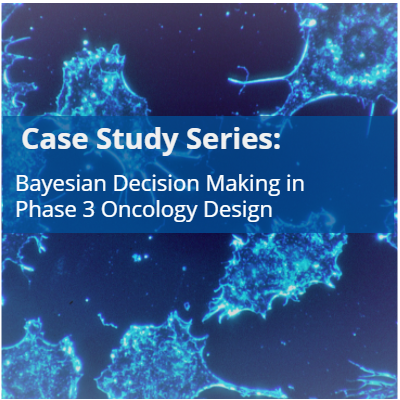.png?width=735&name=0bbd4624-95bf-4ce4-885f-642c983110de%20(2).png)
We continue our case study series with this example of a Phase 3 design that uses Bayesian decision making combined with frequentist final analysis.
Clinical Development Background
Our biopharmaceutical client’s lead drug candidate is a late clinical-stage cancer immunotherapy for treatment of a rare oncology indication. Clinical development of therapies in this indication faces inherent challenges of patient recruitment and scarcity of data.
Sponsor Challenge
The sponsor had previously conducted a randomized, double-blind, placebo-controlled Phase 2 study. Moving into a confirmatory clinical trial setting, they came to Cytel for support with a trial design to address their key questions:
- How do we design a trial that makes most productive use of the prior information obtained from the Phase 2 study?
- Given the scarcity of data available, how can we identify the best sample size to take forward to appropriately detect the effect size?
Cytel solution
Cytel strategic consulting provided clinical trial design services including associated activities such as development of simulations.
Cytel ultimately proposed a 3-look adaptive study design to compare the efficacy of the compound versus control in patients with this rare indication after surgery and chemotherapy.
The design incorporates a first go/ no-go interim analysis, with a subsequent sample size re-estimation interim analysis and a final analysis.
The primary endpoint is Overall Survival (OS) but since there is not expected to be sufficient OS data at the first interim analysis Progression Free Survival ( PFS) is used combined with the prior data available from the Phase 2 study to make the go/ no-go decision.
The second interim analysis is based on OS, and at this look a decision will be made to either stop the trial for efficacy or futility or continue the trial until reaching a specified number of deaths.
If the trial is not stopped for efficacy a sample size adaptation will be considered based on a promising zone design ( 1) ( Mehta and Pocock 2010).
Outcomes
The design has overcome the challenges faced by the client of rarity of data within the indication and the assessment of sample size. It efficiently makes use of prior data to inform go/ no-go decision-making.
References
Mehta, C.R. and Pocock, S.J. (2010) ‘Adaptive increase in sample size when interim results are promising: A practical guide with examples’, Statistics in Medicine, 30(28), pp. 3267–3284. doi: 10.1002/sim.4102.
Further Reading
Bayesian Approaches in Clinical Trials
Case Study: Adaptive Bayesian Design with Informative Prior



.png?width=735&name=0bbd4624-95bf-4ce4-885f-642c983110de%20(2).png)